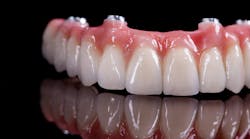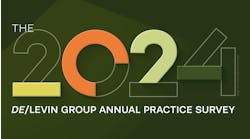Delivering a crown or lab-produced prosthetic requires two actions. One, the patient has agreed to the services performed, and two, the patient has paid for the services.
Does your laboratory have a collection of unseated crowns or other restorations that need immediate attention? Though uncommon in most practices, those without management systems may find themselves in this predicament, which can be a financial and emotional drain to the dentist and team.
The usual scenario is that the patient pays half the fee on the preparation date and the balance at the seat or delivery date. There is no insurance payment involved. But what if the patient cancels the seat appointment and does not reschedule? Other patients have scheduling issues and say they’ll come in soon, while others share other excuses, but you need to resolve these promptly.
Unseated crowns are usually the result of not collecting payment in full at the preparation appointment. How does this happen?
- The patient verbally agrees to pay the balance at delivery. They must remember the agreement and have the money to pay.
- The patient does not sign a written financial agreement or insurance estimation. They are surprised that you require the balance now. The method of payment or options should have been discussed.
- The patient doesn’t understand the risks of wearing a temporary or interim restoration for an extended period and thinks it’s OK to wear it indefinitely until they can pay.
You might also be interested in: Importance of strong patient payment programs in dental practices
Can the dentist demand payment before the prosthetic is seated?
If the patient or guarantor has paid half the bill and doesn't have the remainder either in cash or credit card, have them apply for outside funding or suggest they reach out to a family member or friend for the balance. It lets them know you’re trying to help them solve the problem.
The crown must be seated correctly and promptly to be ethical and legal. You should set up a written payment plan if that doesn't work. Once the patient agrees to the payment terms in writing, you can turn them over to collections if they renege on the agreement. You can also dismiss the patient from the practice (by state law).
Not seating the crown does not favorably serve the dental practice. The temporary will eventually fall out, and the tooth may shift or become damaged. The person is still a patient of record, and you may have to reprep and make another crown. This may lead the patient to post a negative review on social media or file a complaint with the dental society or dental board.
Along with the financial agreement, you should send a certified letter (return receipt) addressing the following concerns:
- Your concern for the patient's long-term health and welfare
- The long-term prognosis of the tooth/teeth without a permanent crown
- The probability of new crown(s) not fitting if the temps come off and the tooth structure is compromised
- The possibility of unnecessary extra expense due to additional services
To avoid these problems in the future, collect full payment in advance with cash, cashier’s check, or major credit cards, or secure patient funding through an outside lender such as CareCredit. Since more than two-thirds of the work has been performed by the seat appointment, it doesn't make sense to collect only 50%. If this were a same day crown, you would collect 100%.
What if the patient has insurance and doesn't appoint for the seat?
You can bill the insurance for the crown, but you will need to explain why the crown was not seated and send a narrative and documentation to insurance to justify the crown (medical necessity). Include chart notes, pretreatment x-ray, final x-ray, and diagnostic narrative (or predetermination) justifying the crown in your packet.
Send a copy of the lab prescription and lab bill for the crown. Also explain why you did not follow through with the crown delivery and provide a copy of your attempts to reach the patient. Include a copy of the certified letter sent to the patient encouraging them to complete treatment, and the possibility of adverse outcomes if the crown is not seated. The date of service on the claim should be the preparation date and should include the reason it was not placed.
Each plan policy is different. Some will pay the contracted amount or a prorated amount allowing for the chair time and lab fee, and some will pay nothing. You can always appeal if it’s not in your favor. The situation is preventable when you provide every patient with a treatment estimate, informed consent, and financial options before starting treatment.
This article originally appeared in DE Weekend, the newsletter that will elevate your Sunday mornings with practical and innovative practice management and clinical content from experts across the field. Subscribe here.






